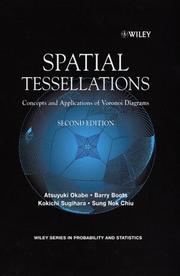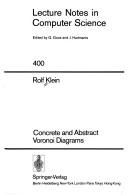| Listing 1 - 10 of 10 |
Sort by
|
Book
Year: 2016 Publisher: [Aberdeen Proving Ground, Md.] : US Army Research Laboratory,
Abstract | Keywords | Export | Availability | Bookmark
 Loading...
Loading...Choose an application
- Reference Manager
- EndNote
- RefWorks (Direct export to RefWorks)
Book
ISBN: 086094221X 9780860942214 Volume: 45 Publisher: Norwich: Geo books,
Abstract | Keywords | Export | Availability | Bookmark
 Loading...
Loading...Choose an application
- Reference Manager
- EndNote
- RefWorks (Direct export to RefWorks)
Voronoi polygons. --- Spatial analysis (Statistics) --- Polygones de Voronoi --- Analyse spatiale (Statistique) --- Voronoi polygons

ISBN: 0471986356 9780471986355 Year: 2000 Publisher: Chichester : Wiley,
Abstract | Keywords | Export | Availability | Bookmark
 Loading...
Loading...Choose an application
- Reference Manager
- EndNote
- RefWorks (Direct export to RefWorks)
Geometry --- Mathematical statistics --- Voronoi polygons --- Spatial analysis (Statistics) --- Data processing --- Voronoi polygons. --- Data processing. --- Spatial analysis (Statistics). --- Geometry - Data processing
Book
ISBN: 9789814447638 9814447633 Year: 2013 Publisher: [Hackensack, ] New Jersey : World Scientific,
Abstract | Keywords | Export | Availability | Bookmark
 Loading...
Loading...Choose an application
- Reference Manager
- EndNote
- RefWorks (Direct export to RefWorks)
Voronoi polygons --- Spatial analysis (Statistics) --- Polygones de Voronoi --- Analyse spatiale (Statistique)
Book
ISBN: 0769550371 1479905488 9780769550374 Year: 2013 Publisher: IEEE
Abstract | Keywords | Export | Availability | Bookmark
 Loading...
Loading...Choose an application
- Reference Manager
- EndNote
- RefWorks (Direct export to RefWorks)
Voronoi polygons --- Science --- Engineering mathematics --- Mathematics --- Natural science --- Natural sciences --- Science of science --- Sciences --- Diagrams, Voronoi --- Thiessen polygon method --- Thiessen polygons --- Voronoi diagrams --- Polygons
Book
ISBN: 3642103022 9786612837333 3642103456 1282837338 Year: 2010 Publisher: Heidelberg ; London : Springer,
Abstract | Keywords | Export | Availability | Bookmark
 Loading...
Loading...Choose an application
- Reference Manager
- EndNote
- RefWorks (Direct export to RefWorks)
What is space? Is there space when there are objects to occupy it or is there space only when there are no objects to occupy it? Can there be space without objects? These are old philosophical questions that concern the ontology of space in the philosophical sense of ‘ontology’ – what is the nature of space? Cognitive science in general and arti?cial intelligence in particular are less c- cerned with the nature of things than with their mental conceptualizations. In spatial cognition research we address questions like What do we know about space? How is space represented? What are the representational entities? What are the rep- sentational structures? Answers to these questions are described in what is called ontologies in arti?cial intelligence. Different tasks require different knowledge, and different representations of knowledge facilitate different ways of solving problems. In this book, Jan Oliver Wallgrün develops and investigates representational structures to support tasks of autonomous mobile robots, from the acquisition of knowledge to the use of this knowledge for navigation. The research presented is concerned with the robot mapping problem, the pr- lem of building a spatial representation of an environment that is perceived by s- sors that only provide incomplete and uncertain information; this information usually needs to be related to other imprecise or uncertain information. The routes a robot can take can be abstractly described in terms of graphs where alternative routes are represented by alternative branches in these route graphs.
Engineering. --- Mobile robots -- Programming. --- Spatial data infrastructures. --- Voronoi polygons. --- Robots --- Mobile robots --- Voronoi polygons --- Spatial data infrastructures --- Mechanical Engineering --- Mechanical Engineering - General --- Engineering & Applied Sciences --- Dynamics --- Programming --- Programming. --- Diagrams, Voronoi --- Thiessen polygon method --- Thiessen polygons --- Voronoi diagrams --- SDIs (Geographic information systems) --- Artificial intelligence. --- Robotics. --- Automation. --- Robotics and Automation. --- Artificial Intelligence (incl. Robotics). --- Geographic information systems --- Polygons
Book
ISBN: 0471934305 9780471934301 Year: 1992 Publisher: Chichester : Wiley,
Abstract | Keywords | Export | Availability | Bookmark
 Loading...
Loading...Choose an application
- Reference Manager
- EndNote
- RefWorks (Direct export to RefWorks)
Voronoi polygons. --- Spatial analysis (Statistics) --- Geometry --- Data processing. --- 519.14 --- Voronoi polygons --- Diagrams, Voronoi --- Thiessen polygon method --- Thiessen polygons --- Voronoi diagrams --- Polygons --- Special combinatorial arrays and configurations. Special matrices. Binary matrices. Hadamard matrices etc. Block designs. Tessellation problems --- 519.14 Special combinatorial arrays and configurations. Special matrices. Binary matrices. Hadamard matrices etc. Block designs. Tessellation problems --- Analysis, Spatial (Statistics) --- Correlation (Statistics) --- Spatial systems --- Data processing --- Spatial analysis (Statistics). --- Polygones --- Géométrie --- Géométrie algorithmique --- Géometrie combinatoire --- Geometry - Data processing --- Géométrie algorithmique --- Géometrie combinatoire --- Géométrie
Book
ISBN: 9783540851264 3540851259 9783540851257 3540851267 Year: 2008 Publisher: Berlin : Springer,
Abstract | Keywords | Export | Availability | Bookmark
 Loading...
Loading...Choose an application
- Reference Manager
- EndNote
- RefWorks (Direct export to RefWorks)
The year 2008 is a memorial year for Georgiy Voronoi (1868 -1908), with a number of events in the scientific community commemorating his tremendous contribution to the area of mathematics, especially number theory, through conferences and scientific gatherings in his honor. A notable event taking place in September 2008 a joint conference: the 5th Annual International Symposium on Voronoi Diagrams (ISVD) and the 4th International Conference on Analytic Number Theory and Spatial Tessellations held in Kyiv, Georgiy Voronoi’s native land. The main ideas expressed by G. Voronoi’s through his fundamental works have influenced and shaped the key developments in computation geometry, image recognition, artificial intelligence, robotics, computational science, navigation and obstacle avoidance, geographical information systems, molecular modeling, astrology, physics, quantum computing, chemical engineering, material sciences, terrain modeling, biometrics and other domains. This book is intended to provide the reader with in-depth overview and analysis of the fundamental methods and techniques developed following G. Voronoi ideas, in the context of the vast and increasingly growing area of computational intelligence. It represents the collection of state-of-the art research methods merging the bridges between two areas: geometric computing through Voronoi diagrams and intelligent computation techniques, pushing the limits of current knowledge in the area, improving on previous solutions, merging sciences together, and inventing new ways of approaching difficult applied problems. Some chapters of the book were invited following the successful 3rd Annual International Symposium on Voronoi Diagrams (ISVD’06), that took place in Banff, Canada, in June 2006. Some others are direct submissions by leading international experts in the prospective areas.
Engineering. --- Appl.Mathematics/Computational Methods of Engineering. --- Artificial Intelligence (incl. Robotics). --- Artificial intelligence. --- Engineering mathematics. --- Ingénierie --- Intelligence artificielle --- Mathématiques de l'ingénieur --- Geometry --- Voronoi polygons --- Computational intelligence --- Engineering & Applied Sciences --- Mathematics --- Civil & Environmental Engineering --- Physical Sciences & Mathematics --- Civil Engineering --- Computer Science --- Applied Mathematics --- Data processing --- Voronoi polygons. --- Computational intelligence. --- Intelligence, Computational --- Diagrams, Voronoi --- Thiessen polygon method --- Thiessen polygons --- Voronoi diagrams --- Applied mathematics. --- Engineering --- Engineering analysis --- Mathematical analysis --- AI (Artificial intelligence) --- Artificial thinking --- Electronic brains --- Intellectronics --- Intelligence, Artificial --- Intelligent machines --- Machine intelligence --- Thinking, Artificial --- Bionics --- Cognitive science --- Digital computer simulation --- Electronic data processing --- Logic machines --- Machine theory --- Self-organizing systems --- Simulation methods --- Fifth generation computers --- Neural computers --- Construction --- Industrial arts --- Technology --- Artificial intelligence --- Soft computing --- Polygons --- Mathematical and Computational Engineering. --- Artificial Intelligence.
Book
ISBN: 3642419046 3642419054 Year: 2013 Publisher: Berlin, Heidelberg : Springer Berlin Heidelberg : Imprint: Springer,
Abstract | Keywords | Export | Availability | Bookmark
 Loading...
Loading...Choose an application
- Reference Manager
- EndNote
- RefWorks (Direct export to RefWorks)
This, the 20th issue of the Transactions on Computational Science journal, edited by Bahman Kalantari, is devoted to the topic of Voronoi Diagrams and their applications. The 10 full papers included in the volume are revised and extended versions of a selection of papers presented at the International Symposium on Voronoi Diagrams 2012, held in Rutgers, NJ, USA, in June 2012. They provide an in-depth overview of current research on topological data structures and a comprehensive evaluation of their applications in the fields of cartography, physics, material modeling, chemistry, GIS, motion planning and computer graphics.
Engineering & Applied Sciences --- Technology - General --- Computer science. --- Artificial intelligence. --- Computer graphics. --- Image processing. --- Computer Science. --- Computer Graphics. --- Image Processing and Computer Vision. --- Artificial Intelligence (incl. Robotics). --- Pictorial data processing --- Picture processing --- Processing, Image --- Imaging systems --- Optical data processing --- Automatic drafting --- Graphic data processing --- Graphics, Computer --- Computer art --- Graphic arts --- Electronic data processing --- Engineering graphics --- Image processing --- AI (Artificial intelligence) --- Artificial thinking --- Electronic brains --- Intellectronics --- Intelligence, Artificial --- Intelligent machines --- Machine intelligence --- Thinking, Artificial --- Bionics --- Cognitive science --- Digital computer simulation --- Logic machines --- Machine theory --- Self-organizing systems --- Simulation methods --- Fifth generation computers --- Neural computers --- Informatics --- Science --- Digital techniques --- Voronoi polygons. --- Computer science --- Mathematics. --- Computer mathematics --- Discrete mathematics --- Diagrams, Voronoi --- Thiessen polygon method --- Thiessen polygons --- Voronoi diagrams --- Polygons --- Mathematics --- Computer vision. --- Artificial Intelligence. --- Machine vision --- Vision, Computer --- Artificial intelligence --- Pattern recognition systems --- Optical data processing. --- Optical computing --- Visual data processing --- Integrated optics --- Photonics --- Computers --- Optical equipment

ISBN: 0387520554 3540520554 3540468749 Year: 1990 Volume: 400 Publisher: Berlin Heidelberg New York Tokyo Springer
Abstract | Keywords | Export | Availability | Bookmark
 Loading...
Loading...Choose an application
- Reference Manager
- EndNote
- RefWorks (Direct export to RefWorks)
Voronoi polygons --- Spatial analysis (Statistics) --- Geometry --- Polygones de Voronoi --- Analyse spatiale (Statistique) --- Géométrie --- Data processing --- Informatique --- 681.3*E1 --- 681.3*F22 --- 681.3*H33 --- 681.3*I35 --- 681.3*I35 Computational geometry and object modeling (Computer graphics) --- Computational geometry and object modeling (Computer graphics) --- 681.3*H33 Information search and retrieval: clustering; query formulation; retrieval models; search process; selection process --- Information search and retrieval: clustering; query formulation; retrieval models; search process; selection process --- 681.3*E1 Data structures: arrays; graphs; lists; tables; trees --- Data structures: arrays; graphs; lists; tables; trees --- 681.3*F22 Nonnumerical algorithms and problems: complexity of proof procedures; computations on discrete structures; geometrical problems and computations; pattern matching --See also {?681.3*E2-5}; {681.3*G2}; {?681.3*H2-3} --- Nonnumerical algorithms and problems: complexity of proof procedures; computations on discrete structures; geometrical problems and computations; pattern matching --See also {?681.3*E2-5}; {681.3*G2}; {?681.3*H2-3} --- Information systems
| Listing 1 - 10 of 10 |
Sort by
|

 Search
Search Feedback
Feedback About UniCat
About UniCat  Help
Help News
News